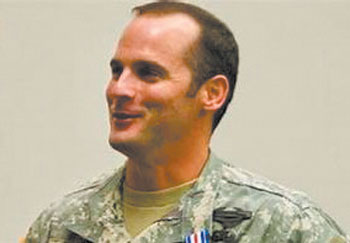 War hero or murderer? It’s a question that has dogged the military career of Army Maj. Mathew L. Golsteyn for eight years. Golsteyn’s story is an extraordinary one — a Green Beret decorated for valor in combat who, during a job interview with the C.I.A. in 2011, volunteered that he had killed a suspected bomb-maker a year earlier in Afghanistan. The Army opened an investigation but did not charge Golsteyn, instead stripping him of a Silver Star and issuing a letter of reprimand.
War hero or murderer? It’s a question that has dogged the military career of Army Maj. Mathew L. Golsteyn for eight years. Golsteyn’s story is an extraordinary one — a Green Beret decorated for valor in combat who, during a job interview with the C.I.A. in 2011, volunteered that he had killed a suspected bomb-maker a year earlier in Afghanistan. The Army opened an investigation but did not charge Golsteyn, instead stripping him of a Silver Star and issuing a letter of reprimand.
President Donald Trump intervened in the case via Twitter, saying, “I will be reviewing the case of a U.S. Military hero, Major Matt Golsteyn, who is charged with murder.” As commander in chief, Trump complicated the military’s case against Golsteyn, raising questions of undue command influence, as well as the possibility that the prosecution is bound to be short-circuited by a pardon. With that tweet, Trump made an extraordinary intervention into the American judicial system.
“Major Golsteyn admitted to what appears to be a summary execution — a very serious crime under international law, and it is vital that the investigation go forward,” said Patricia Gossman, senior researcher for Afghanistan at Human Rights Watch.
Three years ago, in an appearance on Fox News, Major Golsteyn again said he had shot the Afghan. The Army opened a second investigation in late 2016, and charged Golsteyn with murder. In an interview, Golsteyn’s lawyer, Phillip Stackhouse, called the Army’s decision to charge his client with murder a case of “political correctness,” and said he was glad that Trump was going to look into it.
Golsteyn was in Afghanistan in 2010 during the battle for the city of Marja in the Helmand Province. More than 15,000 American, Afghan, British, Canadian, Danish and Estonian troops attacked the Taliban stronghold. Over the next several months, dozens of Americans were killed, and hundreds were wounded. In February of that year, a roadside bomb killed two Marines who had been working with Major Golsteyn’s Green Beret team. There are conflicting accounts of what happened next.
Army documents, which claim to recount what Major Golsteyn told the C.I.A., suggest that he and his team began clearing buildings looking for the source of the roadside bomb, eventually finding explosive materials like those used in the bomb that killed the Marines. The team took a suspected bomb-maker back to its base where he was identified as a member of the Taliban. Golsteyn and another American soldier, concerned that if released, the man would kill American troops, took him off the base, shot and killed him and buried his remains in a shallow grave, the documents say.
According to public reporting and his admission, Golsteyn returned to the burial site to retrieve the body and burned it in a burn pit. Prosecutors say such alleged actions provide powerful insight into the major’s criminal state of mind at the time of the killing. A court-martial is set for Dec. 2 at Fort Bragg, the home of Army Special Operations. Golsteyn will stand trial for premeditated murder. He pleaded not guilty in July.
Pictured: Maj. Matthew Goldsteyn

 How to resolve AdBlock issue?
How to resolve AdBlock issue? 








